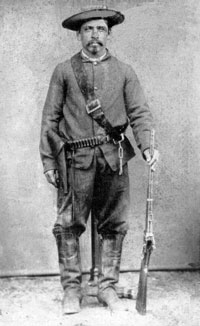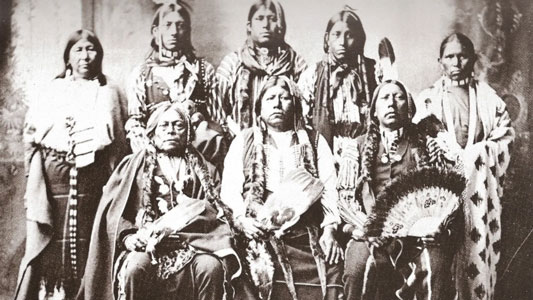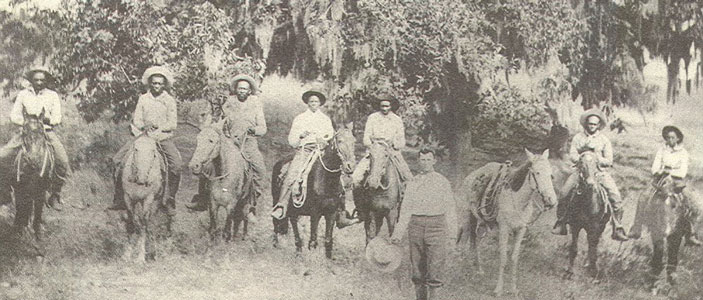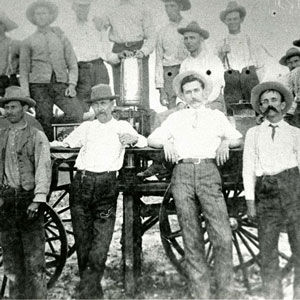About this Website

Tejano unionist
By the early decades of the nineteenth century, Texas had become one of the most ethnically and racially diverse regions in North America. Indigenous peoples mingled with newly-established Hispano settlements throughout the region during the 1700s, while nomadic and semi-nomadic tribal groups from the West made their way into Texas in search of the buffalo herds that roamed the Low Plains. A new pattern of migration would begin in the early 1800s in the form of a steady stream of Native American refugees (the Cherokees, Shawnees, Delawares and many others) who had been displaced by westward moving whites in the United States. In the years following Mexican independence in 1821, the region was opened up to foreign settlement, with many Anglos from the American South bringing enslaved people with them.

Tonkawas, 1800s
The movement of peoples into Texas was not limited to the North American continent. As the price of cotton spiked in the 1830s, some white planters purchased in the slave markets of Havana recently enslaved Yoruba-speaking Africans from the Niger Delta to supplement their labor force. The arrival of large numbers of immigrants from Central Europe in the 1840s contributed to this process of demographic convergence.
Such ethnic and racial diversity led, not surprisingly, to unremitting conflict.

Black cowboys, South Central Texas, 1800s
This project seeks to map incidents of fatal and near-fatal violence among the region’s many ethnic and racial groups over the course of more than a half a century, from the birth of the Mexican republic in the early 1820s to the end of Reconstruction and the so-called “Indian Wars.” While some conflicts, such as the Texas struggle for independence, are well known, the collision of cultures took many forms. Clashes involving state actors--the formally recognized military forces of Mexico, Texas, and the United States—were only a small part of the broader pattern of violence in which the region’s inhabitants competed for economic resources, land, and political control.

Boerne, TX firefighters
These struggles represent a conspicuous and protracted feature of the state’s early modern past. They help to remind us that the history of nineteenth century Texas cannot be understood as a single, over-arching narrative, but as multiple, often interrelated narratives of dominance and survival, leaving an indelible mark on the state we know today.
Credits
This project is funded, in part, by the UTA College of Liberal Arts Initiative of Digital Arts and Humanities (iDAH) and the Summerlee Foundation.
Native American tribal images: Jean Louis Berlandier’s The Indians of Texas in 1830.
Historic map overlay: Texas, engraved by George W. Boynton, from Thomas G. Bradford, An Illustrated Atlas: Geographical, Statistical, and Historical of the United States and the Adjacent Countries (Philadelphia: E. S. Grant, 1838). University of Texas at Arlington Libraries Special Collections. Gift of Virginia Garrett. 126/16 00491. UTA catalog record.
Current Project Personnel
UTA College of Liberal Arts Center for Greater Southwestern Studies
Dr. Sam Haynes, Professor of History and Director of the Center for Greater Southwestern Studies
Jennifer Hilliard, Administrative Assistant
UTA Libraries
Austin Gilmore, Web Developer
Andrew Leverenz, Senior Web Developer
Whitney Russell, Digital Projects Librarian
Former Project Personnel
Harini Akkanapragada, Student Assistant
Ali Behseresht, Graduate Research Associate
Brandon Blakeslee, Graduate Student Researcher
Charles Grand, Graduate Student Researcher
Ramona Holmes, Digital Creation, Department Head
Ben Huseman, Cartographic Archivist
Lynn F. Johnson, Digital Projects Librarian
Simranjeet Kaur, Student Assistant
William Kingren, Graduate Student Researcher
Candy McCormic, Graphic Design Specialist
Rafia Mirza, Digital Humanities Librarian
Barbara Moore, Administrative Assistant
Elias Perez, Student Researcher
Sarbajeet Pulaha, Student Assistant
Krystal Schenk, Web Developer
Chirag Shah, Student Assistant
Elizabeth York, Administrative Assistant

